ceres
Latest
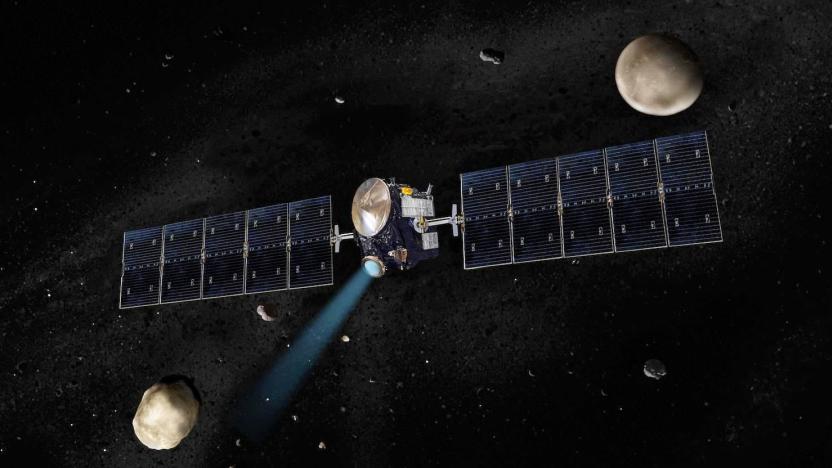
NASA says goodbye to its Dawn spacecraft after 11 years of service
NASA's Dawn spacecraft has run out of fuel, and its mission has come to an end. Launched in 2007, Dawn orbited the two largest bodies in the main asteroid belt -- Vesta and Ceres -- collecting valuable data that have helped scientists understand how objects formed in the early solar system. "Today, we celebrate the end of our Dawn mission -- its incredible technical achievements, the vital science it gave us and the entire team who enabled the spacecraft to make these discoveries," Thomas Zurbuchen, associate administrator of NASA's Science Mission Directorate in Washington, said in a statement. "The astounding images and data that Dawn collected from Vesta and Ceres are critical to understanding the history and evolution of our solar system."
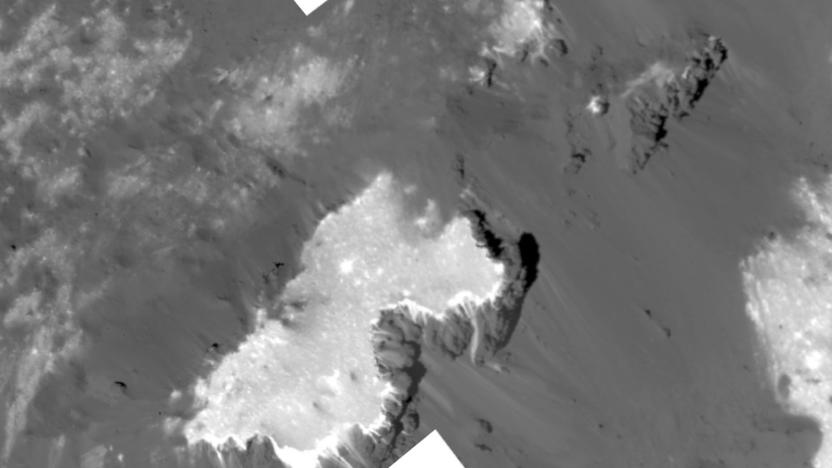
NASA's Dawn spacecraft takes a close-up of Ceres' brightest spot
For its final orbit around Ceres, the Dawn spacecraft fired its ion engine possibly for the last time and dove as close to the dwarf planet as possible to fly merely 22 miles above its surface. That's the closest it's ever been to the celestial body -- the lowest altitude it reached before this was 240 miles above the surface -- and as you'd expect, the current orbit is producing some of the closest images of Ceres we've ever seen. Some of those photos are close-ups of the famous Occator Crater, the site of the dwarf planet's most famous bright spot.

NASA wants your pictures of clouds to verify its satellites’ data
NASA announced this week that it's looking for some citizen scientists to help out with a project. Six orbiting instruments make up NASA's Clouds and the Earth's Radiant Energy System (CERES) project and they are used to study Earth's climate and the role clouds play in climate change. But sometimes it's hard for these instruments to differentiate clouds from other Earthly things. For example, NASA says that thin, wispy cirrus clouds and snow can easily be confused because they're both cold and bright. Differentiation gets even more difficult when these clouds hang out above patches of snow. And that's where citizen scientists come in.
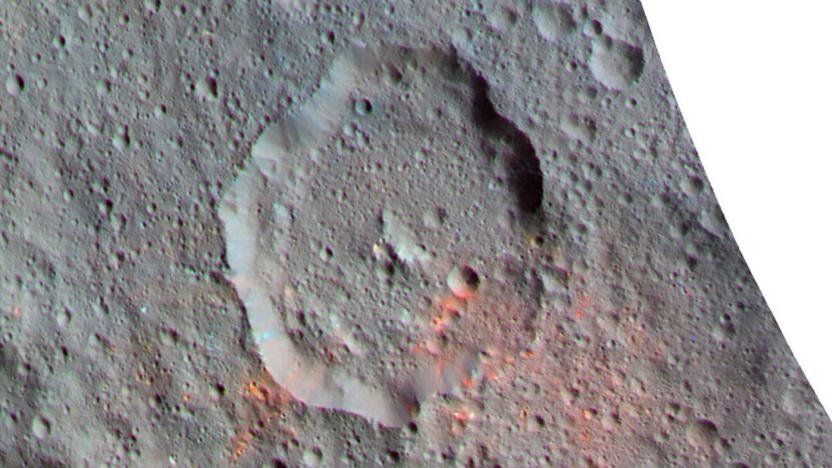
Dawn probe spots organic materials on dwarf planet Ceres
Ceres is now officially included the list of celestial bodies where we've found organic molecules. NASA's Dawn scientists have spotted the presence of organic compounds on the dwarf planet using the spacecraft's visible and infrared mapping spectrometer (VIR). They found the organics covering an area measuring around 400 square miles in and around Ceres' northern-hemisphere crater called Ernutet. They also found smaller patches of land with organics several miles east and west of Ernutet, as well as in another crater. That's pretty abundant, considering Christopher Russell (Dawn's principal investigator) said they weren't "expecting to see something like this on the surface of Ceres" at all.
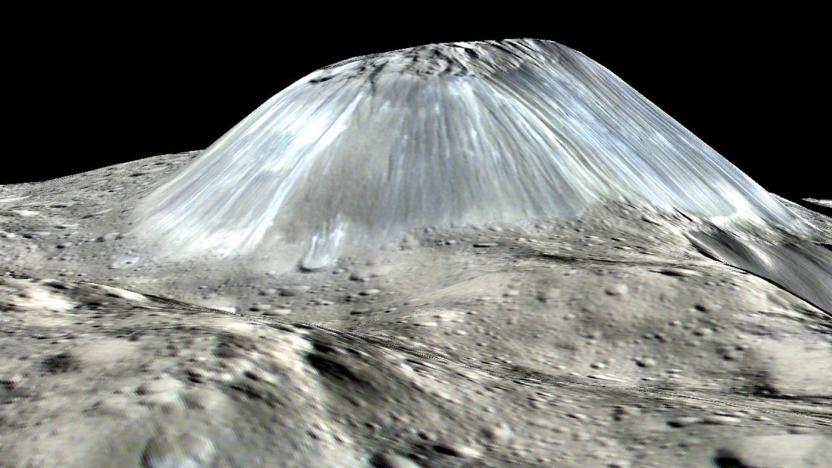
Ancient Ceres may have had plenty of ice volcanoes
Millions of years ago, Ceres' surface might have had plenty of icy volcanoes to keep Ahuna Mons company. Scientists have always found its solitary existence weird anyway. "Imagine if there was just one volcano on all of Earth," University of Arizona in Tucson's Michael Sori said. "That would be puzzling." That's why Sori and his team from the university's Lunar and Planetary Laboratory explored the idea that Ceres used to have many other cryovolcanoes. After taking what we know about the dwarf planet into account, the researchers were able to come up with one possible explanation for the land formations' disappearance: they may have flattened out over time.

Dwarf planet Ceres' surface isn't what scientists expected
As much as we now know about Ceres, it's evident the dwarf planet still has a few surprises left. Astronomers have discovered that Ceres' surface isn't as carbon-rich as previously thought. A fresh batch of infrared scans shows that the surface is likely "contaminated" by material (dry pyroxene dust) from asteroid impacts, mixing in with 'wet' dust, ice and carbonates. While Ceres has previously been lumped into the same composition class as nearby asteroids, it turns out that it merely looks like its neighbors -- it's a different beast altogether when you dive deeper.

Dwarf planet Ceres is 'oozing' with water
Scientists already knew via remote observations that Ceres, the dwarf planet (or humongous asteroid if you prefer), has plenty of water in it. The Dawn probe has now revealed that the asteroid is composed of as much as 30 percent water at the poles, explaining its ice volcano and weird bright spots. "It's just oozing," Planetary Science Institute's Thomas Prettyman told Nature, adding that you'd "just swipe and find the ice table" at Ceres' northern pole.
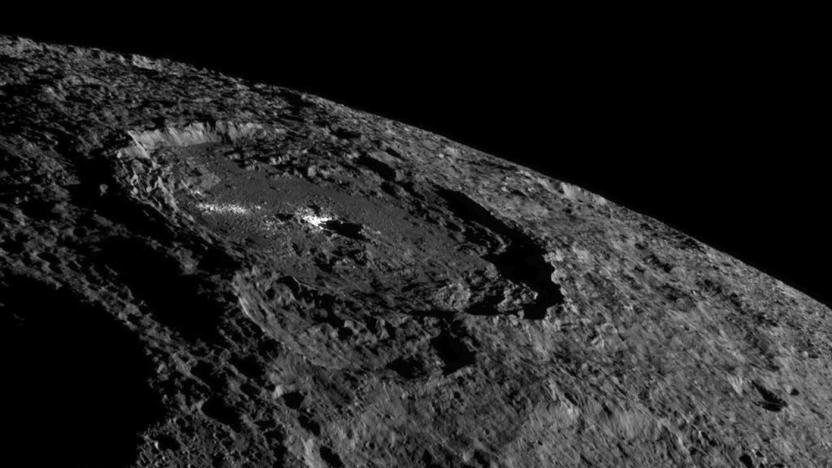
NASA says Ceres' brightest crater is made of salt
The scientists in charge of NASA's Dawn spacecraft has released more high-res images of Ceres, along with information that sheds more light on what it's made of. One of the new images is another close-up of its famous Occator Crater taken from a different angle on October 16th, 920 miles above the dwarf planet. Occator is Ceres' brightest spot, and according to the Dawn team's latest research, it's because the crater is made of salt. The team believes the impact that formed the crater forced a briny liquid to seep out from underground. It froze then immediately turned into vapor, leaving a blanket of salt behind.
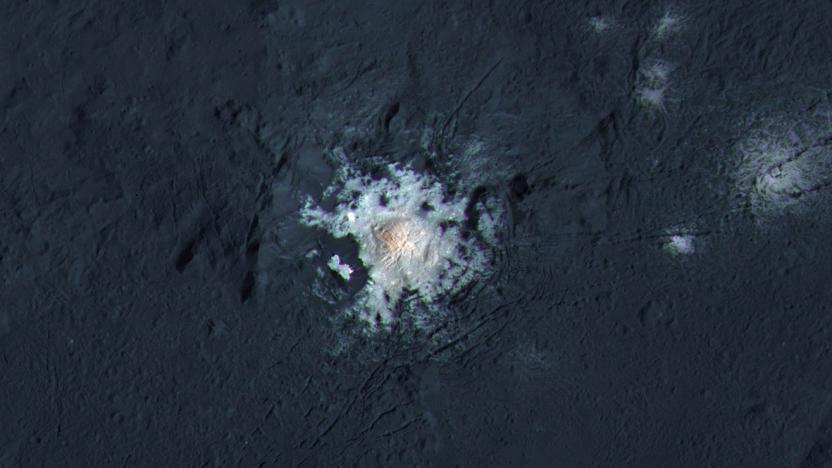
NASA's Dawn mission offers a closer look at the dwarf planet Ceres
If New Horizons is providing us tons of info about Pluto, the Dawn mission is helping us get to know Ceres a lot better. NASA has released new photos and information that the Dawn spacecraft took and gathered in its lowest orbit around the dwarf planet. They've recently found that the brightest area on the celestial body, a spot smack-dab in the center of the Occator Crater, has a dome inside a smooth-walled pit. You can see an image of the area above, which the agency enhanced to highlight the color differences of Ceres' surface.

NASA's closest-ever Ceres photos reveal more odd shapes
NASA's ever-closer inspection of Ceres may have answered some questions, but not all of them... if anything, it might raise a few more. The agency has published its closest-ever photos (240 miles above the surface) of the dwarf planet, and they're revealing details that would have been hard to imagine from further away. Take the crater you see above, for example. It's full of strange, crease-like slopes that researchers believe are the result of collapses while the crater formed. Other snapshots show cracks, probably formed by melting from impacts, and the material (likely salt) that produces Ceres' signature bright spots.

ICYMI: Smartphone picture printer, AR app for all and more
#fivemin-widget-blogsmith-image-568631{display:none;} .cke_show_borders #fivemin-widget-blogsmith-image-568631, #postcontentcontainer #fivemin-widget-blogsmith-image-568631{width:570px;display:block;}try{document.getElementById("fivemin-widget-blogsmith-image-568631").style.display="none";}catch(e){}Today on In Case You Missed It: A case designed to print the pictures that normally just stay on your smartphone is out, just in time for Christmas. Researchers at MIT are doing their best to connect all the smart appliances and gadgets within your home for easy control with a clever app called Reality Editor. And Tokyo's police are forming an anti-drone squad that will use large UAVs with nets to capture smaller drones.

NASA gets to the bottom of Ceres' glowing spots
For months, the bright spots on the surface of Ceres captured by the Dawn spacecraft's cameras have stumped NASA's scientists. Now, thanks to a study led by Andreas Nathues from Germany's Max Planck Institute for Solar System Research, they can finally say that those spots are most likely not volcanic formations. The team has identified the shiny material inside the dwarf planet's craters as hexahydrite: one form of magnesium sulfate. Since that compound is an inorganic salt, you can say that those craters glow due to their salt deposits. You know what else is magnesium sulfate, by the way? Epsom salts -- though it's a different type altogether.

NASA's trippy Ceres map shows what the dwarf planet is made of
No, you're not looking at an artist's watercolor impression of the Moon. That's NASA's false-color map of Ceres, generated using a mix of infrared and visible light filters onboard the Dawn spacecraft currently orbiting the dwarf planet. The resulting psychedelic freakout isn't just for show, of course. The surface temperatures reflected in those colors give scientists an idea of both Ceres' mineral contents and the age of its many craters and ridges. Reddish hues reveal materials that reflect infrared light, while green highlights spots that are much brighter than usual. Even if humanity never touches down on the planet's surface, you'll eventually know what you could expect from a first-hand visit. [Image credit: NASA/JPL-Caltech/UCLA/MPS/DLR/IDA]

NASA's latest Ceres photo shows a strange, conical mountain
If you were hoping that closer-up photos of Ceres would solve some of the dwarf planet's mysteries... well, you'll have to keep waiting. NASA's Dawn probe has transmitted pictures taken from 915 miles up, and one of them shows an odd, conical mountain jutting out of the landscape. Seriously, it's baffling -- its shiny surface and abrupt angles make it look like it was transplanted on an otherwise soft, cratered surface. There's no explanation for what created it (an ancient collision, perhaps?), but it's clearer than ever that even a seemingly featureless celestial body can hold its share of surprises.

NASA shows what it would be like to fly over Ceres
Humans might not fly over the dwarf planet Ceres any time soon, but that doesn't mean you have to wonder what it would be like to soar over this miniature world. NASA just released a simulated flyover that uses real mapping data to give a new perspective on Ceres. The vertical detail is "exaggerated," the agency says, but the video (below) still gives a good sense of what this alien location is like -- it's a tinier, bumpier version of Earth's Moon. And if the level of detail doesn't impress you at the moment, you'll be glad to hear that the Dawn probe is entering ever-lower orbits that should boost the level of detail. Don't be surprised if later models are nearly as good as being there.

Dawn spacecraft captures a sunlit Ceres on cam
The Dawn spacecraft has recently captured the sharpest pictures of Ceres to date, showing the dwarf planet's bright, sunlit north pole. NASA's space probe has been steadily making its way to the celestial body since 2012 after a 14-month stint orbiting the asteroid Vesta. It fired up its ion thrusters in March to slowly approach the Texas-sized proto-planet and settle into orbit, until it reaches an altitude of 233 miles from the surface. Its ultimate goal? To take 3D images and create a high-res map of Ceres, which might harbor some form of water.

Watch NASA's orbiter approach the dwarf planet Ceres at 1PM ET
The largest object in the Main Asteroid Belt between Mars and Jupiter is Ceres, an odd, water-rich proto-planet roughly the size of Texas (590 miles in diameter). Scientists have long puzzled about the origin of the bright white spot near the equator, which we recently learned is two bright spots. We'll soon know a lot more about it as NASA's Dawn spacecraft has nearly reached Ceres. It's already captured shots of the planet (above) and will soon go into a polar orbit at 13,500 km (8,300 miles) before descending to a survey altitude of 4,430 km (2,800 miles). Eventually, it'll drop as low as 1,480km (950 miles) to capture high resolution mapping data and 3D images of Ceres. Once the mission is over it'll remain the asteroid's orbiting buddy forever.

Scientists puzzled by 'bright spots' on surface of dwarf planet Ceres
As NASA's Dawn spacecraft approaches orbit around the dwarf planet Ceres, researchers aren't sure what's causing the "bright spots" on its surface. The imaging orbiter snapped the above picture from 29,000 miles (46,000 km) away just last week, but until it gets closer for a more detailed picture, the folks at NASA aren't ready to decide the light sources' origin. "The brightest spot continues to be too small to resolve with our camera, but despite its size it is brighter than anything else on Ceres," said Andreas Nathues, a lead investigator at the Max Planck Institute for Solar System Research in Germany. "This is truly unexpected and still a mystery to us."

Scientists prove dwarf planet Ceres contains water
Scientists have long thought that the dwarf planet Ceres might hold some form of water, but they've only had indirect evidence at best -- until today, that is. An ESA-led team has used signal fluctiations to confirm that the asteroid belt planetoid is spewing water vapor from two points on its surface, creating both ice and a rudimentary atmosphere. It isn't clear what's producing the vapor, although researchers believe that geysers, thawing or icy volcanoes may be responsible. Whatever is behind Ceres' behavior, the discovery could improve our understanding of how water reached Earth. We'll get a much clearer picture of what's happening in early 2015, when NASA's Dawn probe swings by to map the mini-planet's water activity in greater detail. [Image credit: ESA/ATG medialab/Küppers et al.]





